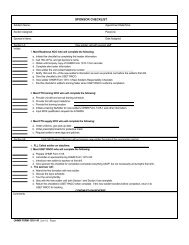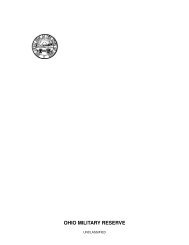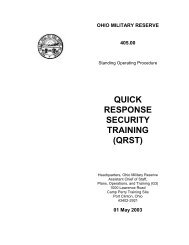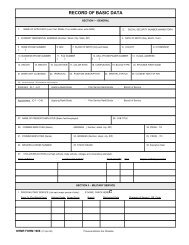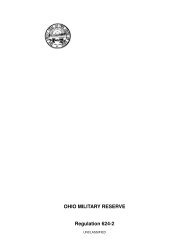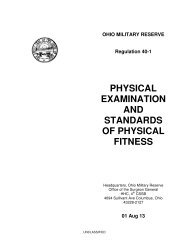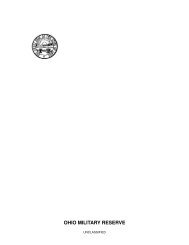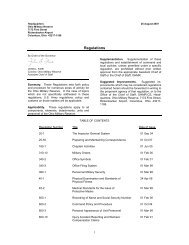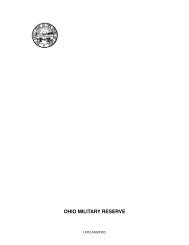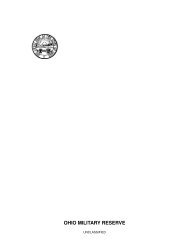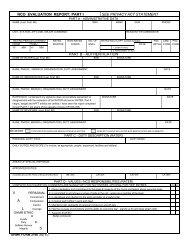OHMR Regulation 600-2 - Ohio Military Reserve
OHMR Regulation 600-2 - Ohio Military Reserve
OHMR Regulation 600-2 - Ohio Military Reserve
- No tags were found...
Create successful ePaper yourself
Turn your PDF publications into a flip-book with our unique Google optimized e-Paper software.
The chain of command is the most fundamentaland important organizational technique used bythe <strong>OHMR</strong>. It is the succession of commanders,superior to subordinate, through whichcommand is exercised. The chain of commandis also known as the command channel. Itextends from the governor as Commander inChief, down through the various grades of rankto the enlisted personnel leading the smallestelement. Staff officers and administrative noncommissionedofficers are not in the chain ofcommand. A simple and direct commandchannel facilitates transmittal of orders from thehighest to the lowest levels in a minimum of timeand with the least chance of misinterpretation.As used in this regulation, no distinction is madebetween the terms commander and leader asthe fundamental policies of command andleadership are applicable at all levels of thechain of command. The command channelextends upward in the same manner for mattersrequiring official communication fromsubordinate to superior. It is <strong>OHMR</strong> policy thateach individual in the chain of command isdelegated sufficient authority to accomplishassigned tasks and responsibilities. Everycommander has two basic responsibilities in thefollowing priority:a. Accomplishing his mission.b. Care of his personnel and property.Normally, efficient accomplishment of themission will help to satisfy the responsibility forthe welfare of his personnel. A superior in thechain of command holds subordinate commandsresponsible for everything their command doesor does not do. Thus, in relation to his superior,a commander cannot delegate any of hisresponsibilities. However, in relation to hissubordinates, he does subdivide hisresponsibility and authority and assigns portionsof them to various commanders and staffmembers. IN this was an appropriate degree ofresponsibility becomes inherent in eachcommand echelon. The necessity of acommander or staff officer observing properchannels in issuing instructions or orders tosubordinates must be recognized. Constant andcontinuous utilization of the chain of command isvital to the effectiveness of any <strong>OHMR</strong> unit.Every effort must be made to acquaint allindividuals with its existence and properfunction.2-2. Staff, technical, and non-commissionedofficer channelsAnother important <strong>OHMR</strong> organizationaltechnique for communication is the staff,technical and non-commissioned officerchannels of communication. The terms staff andtechnical channels is used to describe thevertical or horizontal channel between a staffsection at one headquarters and similar staffsection at another echelon or a parallelheadquarters. The non-commissioned officerchannel originates with the commander of amajor unit and extends downward from thatcommander’s sergeant major to the firstsergeant and on to other non-commissionedofficers and enlisted personnel. These informalchannels are used primarily for the exchange ofinformation and do not supplant the normalchain of command. The staff or technicalchannel is sometimes used for routing reportsand instructions. The non-commissioned officerchannel is often used for the accomplishment ofcertain routine but important tasks andresponsibilities. These include training in basicskills and attributes of a soldier, establishmentand maintenance of NCO standards, properwearing of the uniform, appearance, and militarycourtesy of enlisted personnel. Eachcommander defines his policy on the use ofthese channels to his staff and subordinates.Section 3Command Policies and Procedures3-1. Command of Unitsa. Responsibility. Command of a unit,company size or larger, is normally theresponsibility of the senior assigned officerpresent, provided he is not ineligible under para.3-8.b. Announcement of assumption ofcommand. Assumption of command will beannounced in published orders citing thisregulation as authority.Example:UNIT ORDERS 8-1The undersigned assumes command ofCompany A, 41st IN Bn, 4th Bde, in accordancewith paragraph 3-1 of <strong>OHMR</strong> <strong>Regulation</strong> <strong>600</strong>-2.NOTE: The date of the order is the effectivedate of assumption of command. Companycommanders will utilize unit orders.Commanders of higher levels of command willannounce their assumption of command inspecial orders.7



